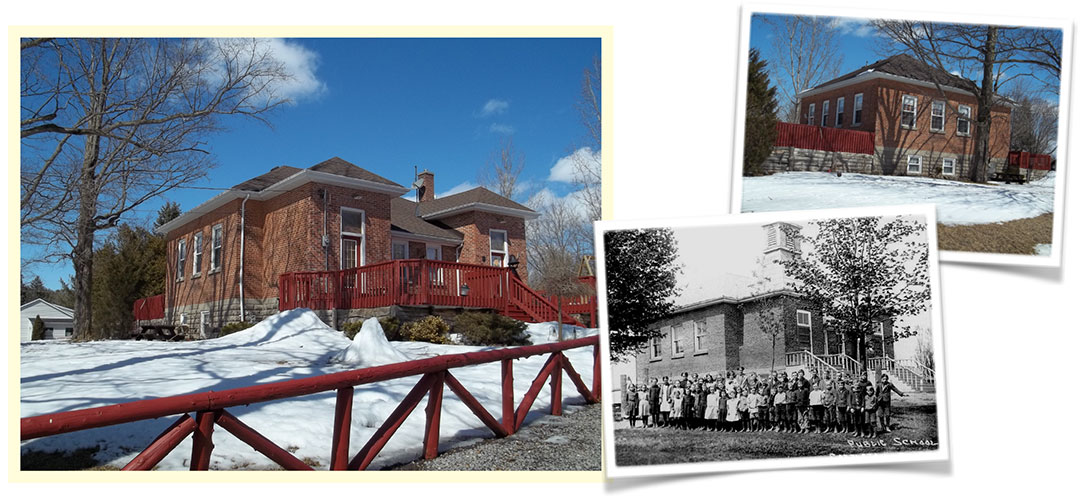157 Norway Street, Castleton
(c.1920s)
Roll No. 1311-011-050-05700 – Cramahe Township Ontario

Ontario Institutional – Public Building
The common denominator in many of these properties is the ubiquitous red brick found throughout Northumberland County. The brick was a staple in the 1800s, emulating, perhaps the double cavity brick walls found in UK houses and public buildings of the era. The UA Loyalists and half pay officers, de- mobbed out of the British army, brought with them a discernible UK design aesthetic.
157 Norway Street has been repurposed into a substantial and sturdy private residence with a large square footprint, two front facade gables and symmetrically placed windows on all four sides. To add to the charm, the windows are all 9 over 9 panes.
Another unique feature of this building is the textile block foundation.
The textile-block houses were named for their richly texture brocade-like concrete walls. The style was an experiment by Frank Lloyd Wright in organic modular housing; he sought to develop an inexpensive and simple method of construction that would
enable ordinary people to build their own homes with stacked blocks. By adding ornamental designs to mass-produced blocks, Wright hoped the blocks could become a “masonry fabric capable of great variety in architectural beauty.”
One writer has described Wright’s concept this way: “By unifying decoration and function, exterior and interior, earth and sky — perforated blocks served as skylights — Wright saw his Textile Block Method approach as an utterly modern, and democratic, expression of his organic architecture ideal.”
History or Associative Value
S.S.22, Castleton contained all grades until 1922 when grades 9 through 13 moved to the newly opened Colborne High School. This picture shows teacher Miss Grace Wynn’s class circa 1912. The bell tower in the front centre of the building is long gone now that the house is a residence. Happily its repurposing has spared it the fate of so many other institutional building – demolition. It is a unique and well maintained property which is a part of Castleton’s history.
Additional Historical and Genealogical Information
Cramahe Township, Concession 7, Lot 33, Castleton Lot 148
The 200 acres of Lot 33, Concession 7, which includes much of modern-day Castleton, were granted by the Crown to Catherine Williamson (1800-1879), Martha Byrns (1797-1870), Sarah Stevens (1794=?), Rebecca Pruyn (1809-?), and Jane Pruyn (1798-?) on 2 April 1832. These were the five daughters of Matthew Pruyn (1762-1813) an Empire Loyalist who settled in Prince Edward County. It is unclear why his daughters were granted this land. There is no evidence that any of them ever lived there.
Rebecca Pruyn sold the 200 acres belonging to herself and her sisters to Joseph Abbott Keeler (1788-1855) on 23 February 1833. Over the next several years Keeler sold of bits and pieces of this land, and what was left went to his son Joseph Keeler (1824-1881) on 23 September 1854.
The younger Keeler sold Castleton Lots 145-148 to James Gardineer Webb (1837-1914) on 8 March 1866. Webb was a Colborne merchant and no evidence has been seen that he ever resided in Castleton, also there is also no definitive evidence that he didn’t. He was married to Margaret Barbara Jane Moore (1840-1929) and had a son Herbert E. (1865-?). He sold Lots 145-148 to the trustees of School Section No. 22 on 9 July 1870. He eventually went west, residing in Pembina, Dakota Territory in 1885 and eventually dying in Spokane, Washington in 1914.
Lots 145-148 remained school property until 1931.
Castleton, ON K0K 1M0, Canada
